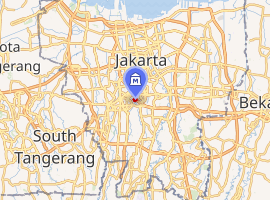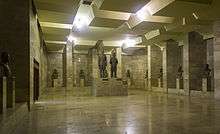Satriamandala Museum
The Satriamandala Museum (also spelled Satria Mandala Museum) is the main museum for the Indonesian Armed Forces. Opened on 5 October 1972, it is located on 5.6 hectares (14 acres) of land in South Jakarta and holds numerous artefacts, weapons, and vehicles.
 | |

| |
| Established | 5 October 1972 |
|---|---|
| Location | South Jakarta, Indonesia |
| Type | Military museum |
| Visitors | Average 48,000 |
Description
The museum is located on Gatot Soebroto Street in West Kuningan, Mampang, South Jakarta, and sits on 5.6 hectares (14 acres) of land;[1][2][3] the exhibitions are divided amongst three buildings and the grounds.[4] It is the main military museum in Indonesia.[2] The name Satria Mandala derives from Sanskrit and translates as "a sacred place for the knights".[2] The museum is open to the general public and has archives for persons researching the history of the armed forces.[5]
History
After 1968,[6] the head of the Indonesian Armed Forces' history branch, Nugroho Notosusanto, conceived of a modern museum showcasing the military's role in Indonesia's development; the available museums in the country, such as the Struggle Museum in Yogyakarta, were underfunded and had poorly defined mission statements.[4][7] There was not yet a museum showing the united role of the military, only museums to the role of the Army, Navy, and Air Force.[6] Notosusanto modeled his design after the Australian War Memorial in Canberra and the Museo Nacional de Historia in Mexico City, Mexico.[4]
At first, the military asked President Suharto to use the presidential palace in Bogor, a request which was denied. They were instead told to use the Wisma Yaso, built in 1960 as a home for then-president Sukarno's Japanese wife Ratna Dewi Sari;[4] the building had a Japanese style.[8] The home was converted to a museum beginning on 15 November 1971. Although development continued until 1979, the museum was formally opened by President Suharto on Armed Forces Day, 5 October 1972.[2][4] On its opening day the museum housed only 20 dioramas.[8]
An additional museum, Waspada Purbawisesa (translated as "Eternal Vigilance Museum"),[9] was built on the grounds in 1987. After a series of protests from conservative Muslim groups were brought down through military force, such as in the Tanjung Priok, the New Order government gave more emphasis to Pancasila education; Waspada Purbawisesa played that role in Satriamandala.[10]
In January 2010 Satriamandala was declared a Cultural Property of Indonesia.[3] It averaged 48,000 visitors years between 2006 and 2008.[11]
Exhibitions

The museum contains numerous exhibitions on the military history of Indonesia. It includes a room dedicated to squadron banners, one dedicated to artefacts belonging to General Oerip Soemohardjo (the military's first Chief of Staff), General of the Army Sudirman (the military's first commander in chief), General Abdul Haris Nasution, and General Suharto.[2][12] A nearby area contains hundreds of rifles, grenades, sharpened bamboo sticks, and other weapons dating from the 1940s and later.[13] A Hall of Heroes holds life-size statues of members of the military who have been declared National Heroes of Indonesia, with Sudirman and Oerip in places of honour at the back of the hall.[14]
There are also 75 dioramas of pre-independence rebellions, the seconds leading to the proclamation of independence, the national revolution, and military efforts after the revolution.[3] The dioramas were created by craftsmen from Yogyakarta.[4][13] Further exhibitions in the building are photographic.[14]
It also includes several war machines, mostly on the museum grounds. This includes the ship KRI Pattimura, which saw action in Papua; aircraft such as the North American AT-16 Harvard, North American B-25 Mitchell, North American P-51 Mustang, the old RI 001 presidential jet, and the Mil Mi-4 helicopter;[2] and land machines such as tanks, ambulances, and a Willys MB belonging to Sudirman.[15]
Waspada Purbawisesa, a five-story pentagon-shaped museum[13] houses dioramas and artefacts from military conflicts against Islamic groups, both conservative and extremist. It includes artefacts from the defeat of the Darul Islam revolt and dioramas of other military conflicts with Islamic groups.[10]
Noteworthy collections
- A draft of the Proclamation of Indonesian Independence in Sukarno's handwriting[15]
- The litter in which General Sudirman was carried during his seven months as a guerrilla[12]
- RI Seulawah 1, a Douglas C-47 Dakota that became The first Presidential Aircraft of the Indonesian Government
- Soviet Weapons and Equipment That have been used During Operation Trikora
- A-4E Skyhawk TT-0438.[16] Acquired from Israel to replace Soviet made aircraft.
References
- Footnotes
- Dimyati 2010, p. 197.
- Jakarta City Government, Satria Mandala, Museum.
- Jakarta City Government, Museum TNI Satria Mandala.
- Tempo 2012, Tidak Sekadar Buat Makan.
- Dimyati 2010, p. 191.
- McGregor 2007, p. 115.
- Adam & Anwar 2005, p. 34.
- McGregor 2007, p. 116.
- McGregor 2007, pp. 6–10.
- McGregor 2007, pp. 182-186.
- BAPPENAS, Jumlah Pengujung Museum.
- Dimyati 2010, p. 192.
- Dimyati 2010, p. 194.
- Kuhnt-Saptodewo, Grabowsky & Großheim 1997, p. 103.
- Pertiwi and Asdhiana 2012, Melongok ke Museum.
- https://aviahistoria.com/2018/04/10/douglas-a-4e-skyhawk-tt-0438-museum-satria-mandala/amp/
- Bibliography
- Adam, Asvi Warman; Anwar, Dewi Fortuna (2005). Violent Internal Conflicts in Asia Pacific: Histories, Political Economies, and Policies. Jakarta: Yayasan Obor. ISBN 978-979-461-514-0.CS1 maint: ref=harv (link)
- Dimyati, Edi (2010). 47 Museum Jakarta: Panduan sang Petualang [47 Museums in Jakarta: A Wanderer's Guide] (in Indonesian). Jakarta: Gramedia Pustaka Utama. ISBN 978-979-22-5501-0.CS1 maint: ref=harv (link)
- "Jumlah Pengujung Museum di Indonesia" [Number of Visitors to Museums in Indonesia] (in Indonesian). Ministry of Culture, Tourism, Youth, and Sports. Archived from the original (PDF) on 21 June 2012. Retrieved 21 June 2012.
- McGregor, Katharine E (2007). History in Uniform: Military Ideology and the Construction of Indonesia's Past. Honolulu: University of Honolulu Press. ISBN 978-9971-69-360-2.CS1 maint: ref=harv (link)
- "Museum TNI Satria Mandala" (in Indonesian). Jakarta City Government. 13 January 2010. Archived from the original on 21 June 2012. Retrieved 21 June 2012.
- Pertiwi F, Ni Luh Made; Asdhiana, I Made (14 April 2012). "Melongok ke Museum Penuh Senapan sampai Panser" [Checking Out Museums Full of Rifles and Pansers]. Kompas (in Indonesian). Archived from the original on 21 June 2012. Retrieved 21 June 2012.
- "Satria Mandala, Museum". Encyclopedia of Jakarta (in Indonesian). Jakarta City Government. Archived from the original on 21 June 2012. Retrieved 21 June 2012.
- Kuhnt-Saptodewo, Sri; Grabowsky, Volker; Großheim, Martin, eds. (1997). Nationalism and Cultural Revival in Southeast Asia: Perspectives from the Centre and the Region. Wiesbaden: Harrassowitz. ISBN 978-3-447-03958-1.CS1 maint: ref=harv (link)
- "Tidak Sekadar Buat Makan" [Not Only for Eating]. Tempo (in Indonesian). 10 November 1973. Archived from the original on 21 June 2012. Retrieved 21 June 2012.